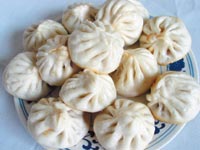 |
 |
|
Best of the buns
By Ye Jun ,Beijing Weekend
Updated: 2004-05-21 15:34

Baozi, still
a staple of Beijingers, dates back almost 1,800
years. | Baozi, a steamed filled bun, is
such a common food in China that most of us take it for granted and don't
particularly look out for it when dining in restaurants.
Yet in Beijing, the variety and quality of the food can satisfy even the
fussiest gourmet.
It is said that the history of baozi dates back to the Three Kingdoms period
(220-280). Zhuge Liang (181-234), a military strategist of the time, was on an
expedition to far South China when his army caught a plague. The incarnation of
wisdom in Chinese history, he invented this foodstuff shaped as a human head and
made of flour and pork and beef to offer as a sacrifice and then as food to cure
the soldiers' plague.
The food, called mantou (flour head), became a typical food of the Chinese
people.
In some parts of southern China, for example Shanghai, steamed bread, either
with stuffing or not, is still called mantou. But in the north, people started
to call stuffed buns baozi, with bao meaning "wrapping."
Baozi became popular partly with the help of some legendary brand names such
as Goubuli and Chenshazi in Tianjin.
These business legends became established in the late Qing Dynasty
(1644-1911). Their success stories, together with the good, simple food, have
become part of Chinese food culture.
Apart from these northern Chinese-style baozi, southern Chinese-style baozi
is also widely available in the capital.
While the northern style is salty, southern style is slightly sweet and
sometimes both sweet and salty. The representative of southern-style baozi is
meigancai (a dried pickled vegetable) stuffing.
Jiasan Guantang (soup) baozi is another famous variation from Xi'an. This is
made of beef and has soup in it.
Beijing has its own baozi legends. Xisi Baozi Restaurant, for example, has
been established for almost a century. The small restaurant is only 38 square
metres but sells 12,000 yuan (US$1,446) worth of baozi a day.
It is not uncommon to see people queuing up to be served.
The secret of its success is sticking to a strict choice and preparation of
material and traditional cooking procedures, according to Ni Yurong, the
restaurant's manager for the past 20 years.
Ni said the correct procedure involves the proportion of ingredients in the
stuffing, time of steaming, making of the wrap and even the sequence of
seasonings added.
The fame of Xisi Baozi Restaurant is largely nostalgic. Baozi, with its meat
stuffing, was a better quality food for many Chinese people in poorer times.
In spite of all the restaurants' efforts, the great variety of food styles
nowadays makes baozi too simple to dominate the dinner table. But it is good
enough as an alternative to your familiar food once in a while.
|
Baozi brief
|
|
Chenshazi (idiot Chen)
Baozi
This is
another famous baozi brand from Tianjin. In contrast to other restaurants,
the most famous baozi here is made of specially processed pig skin and
shrimp.
There are strict requirement
over the proportion of materials and the steaming time.
A feature of the restaurant is the "Baozi Banquet,"
which comprises nine different types including pork, vegetable, spicy and
sweet. These include northern, southern and western styles.
Location: take No 13 bus and get off
at Hepingjie, 200 metres to the south of Hepingdongqiao Flyover on the
Third Ring Road, 2/F Tianjin Hotel, Jinshanchun Restaurant.
Tel: 8425-0324 |
|
Xisi Baozi Restaurant (Er You
Ju)
This is a legendary restaurant known to many
Beijingers. This was what they grew up eating. Today the small baozi
restaurant of only 38 square metres is still known for its high quality.
There are six types of stuffing
including pork and spring onion, vegetable stuffing, as well as sweet and
salty stuffing. It costs from 18 to 26 yuan (US$3.1) to get 500 grams of
baozi.
Location: Xisi southwest
corner.
Tel: 6618-0535 |
|
Goubuli Baozi
Established more than 100 years ago in
Tianjin, its fame has spread across China.
Literally Goubuli means "the dog ignores." In fact it is named after its founder, nicknamed Gouzi,
or "doggie." He had such a good business selling baozi that he had no time
to attend to all of his customers.
There are six branch restaurants in Beijing, the first of which was
its Di'anmen branch. The other branches are at Wangfujing (two branches),
Qianmen, Muxidi and Beijing West Railway Station.
Location: No 55 Di'anmenwai Dajie, northwest corner,
Di'anmen crossroad
Tel: 6404-2460
|
|
Qingfeng Baozi Restaurant
An old brand name in Beijing, it
features baozi stuffed with three fillings, lean pork, mushroom and
shelled shrimps. The baozi here are big.
Location: take buses No 103 or 109, get off
at Xi'anmen Fuyoujie. |
|
Jia San Guantang Baozi (baozi with
soup)
This is a Muslim-style restaurant from Xi'an,
capital of Shaanxi Province. The wrap is made of white flour and stuffing
made of beef and calf marrow soup.
This is famous for containing delicious-tasting soup inside the
wrap. So don't be too rash in biting it.
Location: take No 15, No 19 buses and get off at Fuwai Dajie.
Zhenwumiao Ertiao Food Street, Xicheng District. |
|
Laijinyuxuan Restaurant
This restaurant is famous for recipes taken
from the Qing Dynasty (1644-1911) novel Dream of the Red Chamber.
The baozi here is of southern Chinese
style, the representative of which is meigancai (dried pickled vegetable)
stuffing.
Location: West of Zhongshan
Park
Tel: 6605-6676
|
|
|
| |
Story
Tools |
|
 |
| |
|
|
|
 |
 |
|

